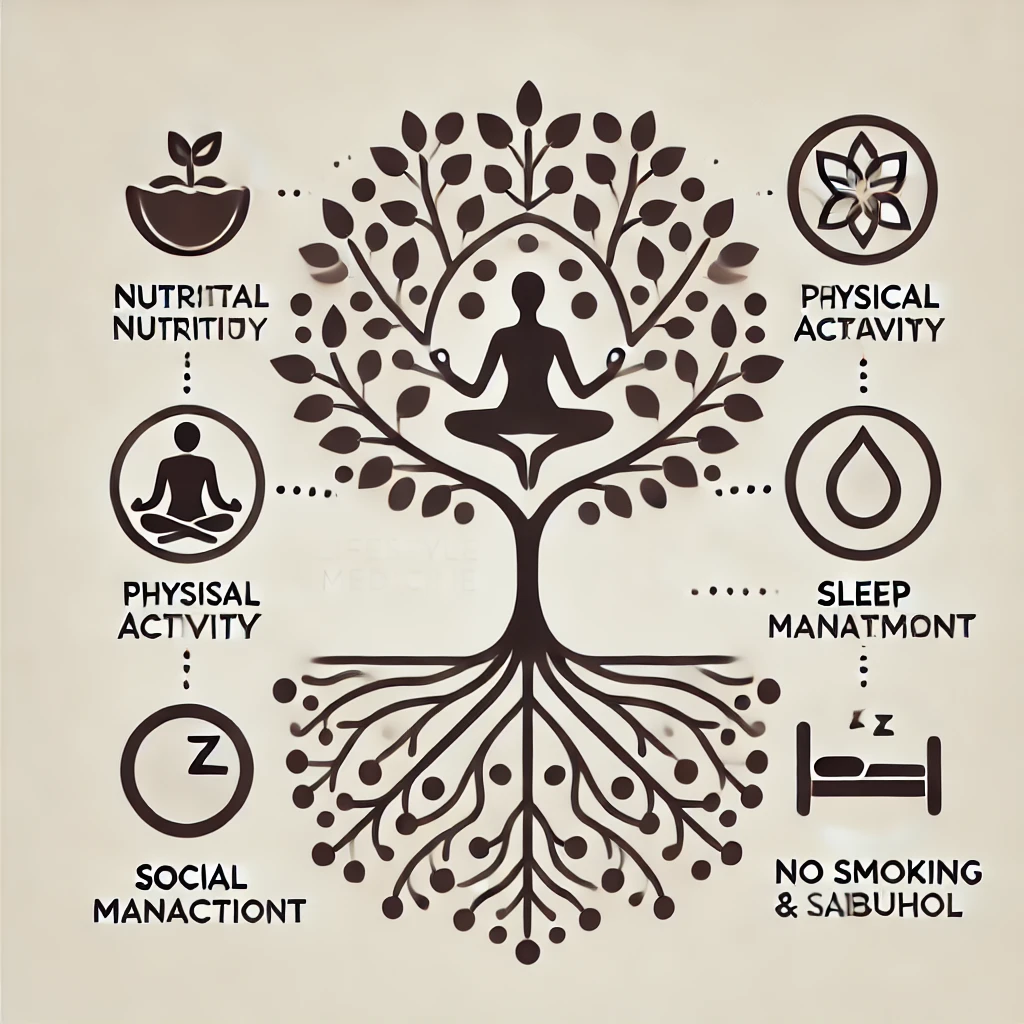
ChatGPT:
The term “lifestyle medicine” began gaining prominence in the late 20th century, particularly in the 1990s, as healthcare professionals increasingly recognized the significant impact of lifestyle factors on chronic diseases. While the concept of using lifestyle changes to improve health has been around for centuries, the formalization of “lifestyle medicine” as a distinct field of practice is more recent.
One of the key milestones in the development of lifestyle medicine was the founding of the American College of Lifestyle Medicine (ACLM) in 2004. The ACLM was established to promote the practice of lifestyle medicine and to provide education and resources for healthcare professionals. The founding of this organization helped to legitimize and formalize the field, encouraging research, education, and the integration of lifestyle interventions into mainstream healthcare.
Lifestyle medicine draws on a body of evidence-based practices that emerged from earlier public health and preventive medicine efforts, but it distinguishes itself by its focus on treating and preventing chronic diseases through comprehensive lifestyle changes. Over time, the field has expanded globally, with many healthcare providers and institutions adopting lifestyle medicine principles as part of their standard care practices.
Lifestyle medicine is a branch of medicine that focuses on the use of lifestyle interventions in the prevention, treatment, and management of chronic diseases. This approach emphasizes evidence-based practices to improve health and well-being through modifications in key lifestyle areas, such as:
- Nutrition: Adopting a balanced, whole-food, plant-predominant diet to reduce the risk of chronic diseases like heart disease, diabetes, and obesity.
- Physical Activity: Encouraging regular exercise tailored to individual needs to improve physical and mental health.
- Stress Management: Implementing techniques like mindfulness, meditation, and other stress-reduction strategies to enhance mental health and resilience.
- Sleep: Promoting healthy sleep habits to support overall health and well-being.
- Social Connections: Encouraging meaningful social relationships and support systems to improve mental and emotional health.
- Avoidance of Risky Substances: Guiding patients to avoid tobacco, excessive alcohol consumption, and other harmful substances.
Lifestyle medicine often works in conjunction with traditional medical treatments but emphasizes the role of these lifestyle factors in achieving and maintaining good health, often reducing or eliminating the need for medications over time.
Evidence-based practice (EBP) refers to the conscientious use of the best available evidence in making decisions about patient care. It integrates three key components:
- Best Research Evidence: This includes the most current, high-quality research findings relevant to the patient’s health condition. These findings typically come from systematic research, clinical trials, and meta-analyses, which provide reliable data on the effectiveness and safety of various treatments and interventions.
- Clinical Expertise: The healthcare provider’s own clinical skills and experience are crucial in interpreting the evidence and applying it to individual patient cases. Clinical expertise helps in assessing the patient’s condition, identifying potential treatment options, and tailoring care to the patient’s unique needs and preferences.
- Patient Values and Preferences: Patient involvement is essential in EBP. This means considering the patient’s values, cultural beliefs, preferences, and circumstances when making care decisions. EBP encourages a collaborative approach, where the patient is actively involved in their own care decisions.
In essence, evidence-based practice is about combining scientific research, clinical experience, and patient preferences to achieve the best possible outcomes in healthcare. It aims to provide high-quality care that is both effective and tailored to the individual needs of patients.
Lifestyle medicine applies to the treatment of chronic diseases by addressing the root causes of these conditions through lifestyle interventions, rather than relying solely on medications or surgical procedures. Here are a few examples of how lifestyle medicine is applied to common chronic diseases:
1. Type 2 Diabetes
- Dietary Changes: A whole-food, plant-based diet low in refined sugars and processed foods can significantly improve blood sugar control. Studies have shown that such dietary changes can reduce or even eliminate the need for diabetes medications in some patients.
- Physical Activity: Regular exercise, such as walking, cycling, or strength training, improves insulin sensitivity and helps maintain healthy blood sugar levels.
- Weight Management: Losing weight through a combination of diet and exercise can reverse type 2 diabetes in some cases.
2. Cardiovascular Disease (CVD)
- Nutrition: A diet rich in fruits, vegetables, whole grains, and healthy fats (like those found in nuts and olive oil) can reduce cholesterol levels and blood pressure, lowering the risk of heart attacks and strokes. The Mediterranean diet is often recommended for heart health.
- Exercise: Regular aerobic exercise (e.g., walking, swimming, cycling) strengthens the heart, reduces blood pressure, and improves cholesterol levels.
- Stress Management: Techniques like mindfulness, yoga, or meditation can help reduce stress, which is a significant risk factor for CVD. Managing stress can lead to lower blood pressure and reduced heart disease risk.
3. Hypertension (High Blood Pressure)
- Dietary Adjustments: Reducing sodium intake and increasing consumption of potassium-rich foods (such as fruits and vegetables) can significantly lower blood pressure. The DASH (Dietary Approaches to Stop Hypertension) diet is often recommended for people with high blood pressure.
- Exercise: Regular physical activity helps maintain healthy blood pressure levels and reduces the risk of complications associated with hypertension.
- Weight Loss: Even a modest weight loss can have a substantial impact on lowering blood pressure.
4. Obesity
- Diet: Adopting a whole-food, plant-based diet low in processed foods and high in nutrient-dense options can promote weight loss and improve overall health. Portion control and mindful eating are also key strategies.
- Physical Activity: Engaging in regular physical activity, both aerobic and strength training, supports weight loss and helps maintain muscle mass while losing fat.
- Behavioral Changes: Lifestyle medicine may incorporate behavioral therapy to address emotional eating, develop healthier eating habits, and sustain long-term weight loss.
5. Chronic Obstructive Pulmonary Disease (COPD)
- Smoking Cessation: The most crucial lifestyle intervention for COPD patients is quitting smoking, as tobacco use is a leading cause of COPD. Lifestyle medicine supports smoking cessation through counseling and behavioral strategies.
- Exercise: Pulmonary rehabilitation, which includes exercise training, can improve lung function and overall quality of life for COPD patients.
- Diet: Maintaining a healthy weight is essential for managing COPD, as being overweight can make breathing more difficult, while being underweight can weaken the respiratory muscles.
6. Depression and Anxiety
- Physical Activity: Regular exercise has been shown to reduce symptoms of depression and anxiety. Physical activity increases endorphin levels, which can improve mood and reduce stress.
- Diet: A diet rich in omega-3 fatty acids, vitamins, and minerals can support brain health and reduce symptoms of depression. There is growing evidence that a Mediterranean-style diet can help manage depression.
- Sleep: Improving sleep hygiene, such as maintaining a regular sleep schedule and creating a restful sleeping environment, can reduce symptoms of depression and anxiety.
In each of these cases, lifestyle medicine focuses on sustainable changes that patients can incorporate into their daily lives. By addressing the underlying causes of chronic diseases through diet, exercise, stress management, and other lifestyle factors, patients often experience significant improvements in their health, sometimes reducing or eliminating the need for medications.

